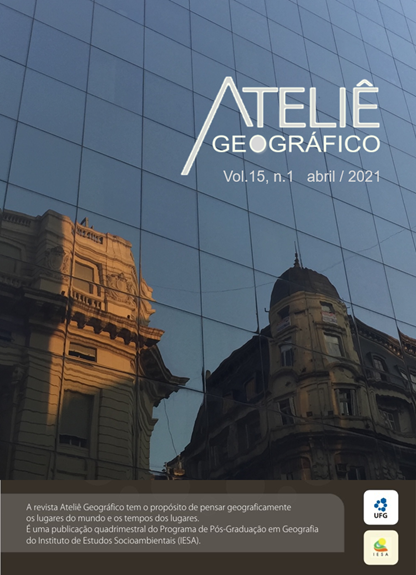Biophysical susceptibility to flooding in the Piracuruca River Hydrographic Sub-basin
DOI:
https://doi.org/10.5216/ag.v15i1.64590Abstract
The study aimed to evaluate the biophysical susceptibility to flooding of the Piracuruca River Hydrographic Sub-basin, based on four environmental indicators - lithological permeability, average relief gradient, circularity index and vegetation index adjusted to the soil (SAVI) – which have been integrated using map algebras. The research employed bibliographic and cartographic survey, use of Geographic Information Systems and map algebra to build the biophysical susceptibility index to floods. Through the study it was inferred that in the Piracuruca River Sub-basin the following prevails: high permeability, which occurs in 58.8% of its area; relief with a flat slope of 58.4%; micro basins with elongated shape and general circularity index ≤ 0.35, which represents a low probability of rapid flooding; vegetation with low photosynthetic activity was identified in 49% of the area. These integrated variables indicate that the average biophysical susceptibility to floods predominates, occurring in 59.5% of the Sub-basin, which indicates the need for further studies to understand the vulnerability of the located population and the creation of strategies to cope with floods.
Keywords: Hydrographic Basin; Natural Disaster; Map Algebra; Biophysical Susceptibility.
Downloads
Downloads
Published
How to Cite
Issue
Section
License
Autores que publicam nesta revista concordam com os seguintes termos:- Autores mantém os direitos autorais e concedem à revista o direito de primeira publicação, com o trabalho simultaneamente licenciado sob a Licença Creative Commons Attribution que permite o compartilhamento do trabalho com reconhecimento da autoria e publicação inicial nesta revista.
- Os autores não serão remunerados pela publicação de trabalhos na Revista Ateliê Geográfico. Além disso, os conteúdos publicados são de inteira e exclusiva responsabilidade de seus autores, ainda que reservado aos editores o direito de proceder a ajustes textuais e de adequação às normas da publicação.
- Autores têm permissão e são estimulados a divulgar seu trabalho online (ex.: em repositórios institucionais ou na sua página pessoal), já que isso pode gerar alterações produtivas, bem como aumentar o impacto e a citação do trabalho publicado (Veja O Efeito do Acesso Livre).


